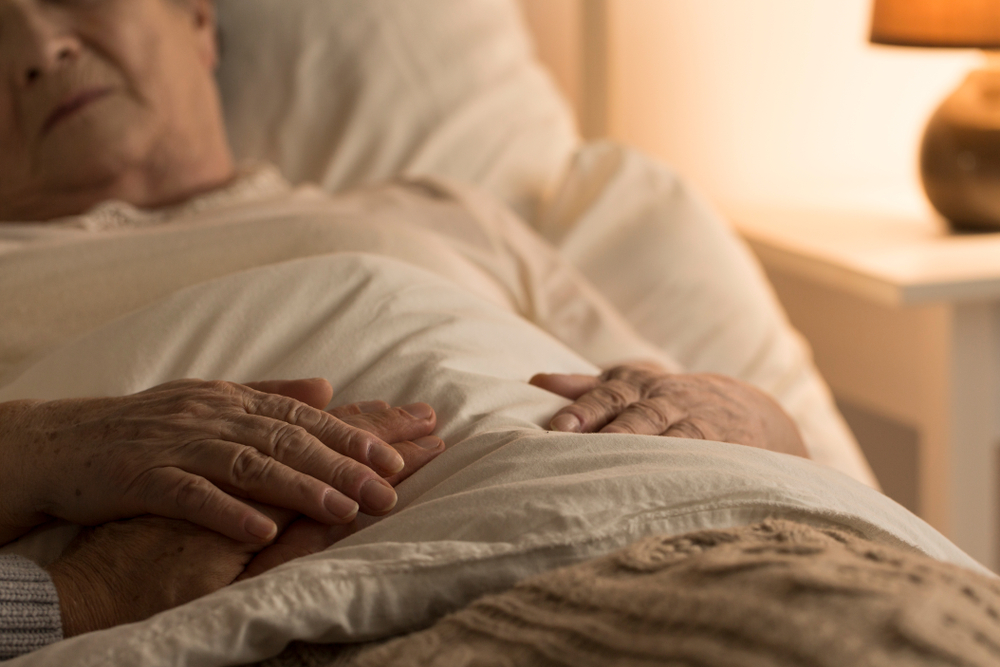When medical professionals note a patient’s temperature dropping in the final hours of life, they’re witnessing one of the most reliable biological signals of approaching death. This temperature decline isn’t merely an interesting physiological footnote—it represents the body’s organized withdrawal from life functions and provides one of the most accurate predictors of imminent death available to medical science.
While many understand that dying people often feel cold to the touch, the complex cascade of biological events creating this temperature drop remains poorly understood outside medical circles. The process involves far more than simple heat loss or circulation changes—it reflects fundamental shifts in metabolism, brain function, and cellular activity as the body conducts its final, carefully orchestrated shutdown sequence.
Let’s explore the remarkable biological processes behind this end-of-life temperature decline, why it occurs with such reliability across different causes of death, and what this phenomenon reveals about how our bodies navigate the transition from life to death. The cooling that precedes death provides a fascinating window into the body’s final physiological processes and the surprising order within what might appear to be simply systemic failure.
The metabolic shutdown that triggers cooling
The temperature decline before death begins at the cellular level as metabolic processes undergo a coordinated reduction through several distinct mechanisms.
Mitochondrial activity decreases dramatically in the hours and days before death. These cellular powerhouses normally generate approximately 90% of our body heat through ATP production. As death approaches, mitochondrial function declines either from primary failure (as in some diseases) or as a controlled response to conserve remaining resources when systems begin failing. This reduced energy production directly translates to decreased heat generation throughout the body.
Thyroid hormone processing changes significantly near death. The thyroid system, which regulates metabolic rate, undergoes complex alterations during the dying process. Even when thyroid hormone levels remain detectable in blood, cellular responsiveness to these hormones decreases significantly. This reduced sensitivity essentially dials down the body’s metabolic thermostat, directly lowering heat production regardless of ambient temperature.
Cellular glucose uptake diminishes progressively as death approaches. The transportation of glucose into cells—a process requiring both energy and functioning membrane systems—becomes increasingly impaired. This reduced cellular fuel intake directly decreases metabolic heat production through both aerobic and anaerobic pathways. Research shows glucose consumption may drop by 30-70% in various tissues during this pre-death phase.
Brown adipose tissue deactivation creates particularly noticeable cooling effects. This specialized fat tissue, which exists specifically to generate heat through non-shivering thermogenesis, becomes increasingly unresponsive to stimulation as death approaches. The deactivation of this dedicated heating system contributes significantly to the progressive temperature decline, particularly in the body’s core.
The metabolic regulatory hierarchy shifts fundamentally as death approaches. Normal temperature regulation prioritizes maintaining core temperature even at the expense of peripheral tissues. In the dying process, this hierarchy gradually dissolves, allowing core temperature to drift downward along with peripheral temperatures rather than maintaining strict central thermal regulation.
The circulatory collapse that accelerates cooling
Beyond metabolic changes, profound alterations in circulation dramatically accelerate heat loss through several specific mechanisms that create the characteristic temperature patterns observed near death.
Peripheral vasoconstriction failure represents a critical turning point in the dying process. Normally, when core temperature drops, blood vessels in extremities constrict to reduce heat loss through the skin. As death approaches, this protective mechanism progressively fails, allowing increased blood flow to body surfaces where heat rapidly dissipates. This circulatory change explains why extremities often cool first, followed by a more gradual core temperature decline.
Cardiac output reduction directly impacts heat distribution throughout the body. As heart function deteriorates, blood flow decreases progressively, reducing the efficiency of heat transfer from metabolically active core organs to the periphery. This diminished circulation creates increasingly uneven temperature distribution, with some body areas cooling much faster than others depending on remaining perfusion patterns.
Blood pressure regulation collapse contributes significantly to temperature dysregulation. The complex systems maintaining adequate blood pressure—including baroreceptors, kidney function, and vascular tone—gradually lose coordination. This dysregulation leads to inadequate tissue perfusion, reducing both metabolic activity and heat distribution in affected areas and accelerating overall cooling.
Microcirculation breakdown represents a particularly important factor in pre-death cooling. The smallest blood vessels, which deliver oxygen and nutrients to tissues, begin failing in complex patterns that vary by underlying cause of death. This capillary dysfunction prevents effective heat transfer at the tissue level, creating “cold spots” that expand and coalesce as death approaches, even when larger vessels remain partially functional.
Hemodynamic redistribution patterns shift dramatically near death. Blood flow priorities that normally preserve brain and heart perfusion become progressively disordered. This chaotic redistribution creates unpredictable temperature patterns across body regions, though the overall trend remains toward cooling as circulation becomes insufficient to maintain normal thermal homeostasis.
The neurological failure that prevents warming
As death approaches, the sophisticated neurological systems responsible for temperature regulation undergo progressive failure through specific degradation patterns that prevent compensatory warming.
Hypothalamic thermoregulation centers lose functional capacity in the hours or days before death. This brain region, essentially the body’s thermostat, becomes increasingly unresponsive to temperature signals. Studies of dying patients show the hypothalamus may actually reset to a lower temperature setpoint, essentially reprogramming the body to maintain a subnormal temperature rather than fight to restore normal levels.
Autonomic response integration deteriorates as death nears. The complex communication between brain temperature centers and effector mechanisms like shivering, vasoconstriction, and metabolic activation becomes increasingly uncoordinated. This communication breakdown prevents effective compensatory responses even when temperature sensors still detect dangerous cooling.
Shivering mechanisms fail through both central and peripheral pathways. The brain circuits triggering shivering become unresponsive, while peripheral muscle tissue simultaneously loses the energy reserves necessary to sustain this heat-generating response. This dual failure eliminates one of the body’s primary defenses against falling temperature.
Behavioral thermoregulation—conscious actions to maintain temperature like seeking warmth or adding clothing—diminishes through cognitive impairment. As brain function declines, awareness of temperature discomfort decreases alongside the ability to respond appropriately. This loss of conscious temperature management accelerates cooling beyond what physiological changes alone would produce.
Feedback loop sensitivity declines progressively throughout the nervous system. Temperature receptors throughout the body become less responsive, while signal transmission to integration centers deteriorates. This sensory degradation means the body becomes increasingly unaware of its own cooling, preventing activation of whatever compensatory mechanisms might still function.
The thermal patterns that predict timing
The progression of temperature changes follows distinctive patterns that experienced healthcare providers use to gauge approximate time until death, though these vary somewhat by the underlying cause.
The Celsius per hour declining rate provides surprisingly consistent timeline predictions. Research tracking temperature in actively dying patients shows average drops of approximately 0.3-0.5°C per hour once the cooling process becomes established. This relatively predictable rate allows healthcare providers to estimate remaining time based on current temperature and the known normal-to-death range of approximately 8-10°C total decline.
Peripheral-central temperature gap changes signal progression phases. Early in the dying process, extremities may be significantly cooler than core temperature. As death approaches, this gap progressively narrows, with extremity and core temperatures converging approximately 2-6 hours before death in most patients. This convergence pattern provides a more reliable timeline indicator than absolute temperature alone.
Circadian rhythm dissolution creates distinctive temperature pattern changes. Normal daily temperature fluctuations (typically about 0.5°C between morning and evening) gradually flatten and disappear as death approaches. This rhythm loss typically occurs 24-48 hours before death, providing an early indicator of imminent decline even before significant cooling begins.
Rewarming resistance increases as death approaches. In earlier stages, external warming measures may temporarily increase body temperature. As death nears, the same interventions produce progressively smaller and shorter-lived temperature increases. The point at which external warming creates no measurable temperature response typically signals death within hours.
Temperature plateaus sometimes interrupt the otherwise steady decline. These temporary stabilizations, typically lasting 1-3 hours, often create false hope of improvement. However, research shows these plateaus almost always give way to accelerated cooling rates afterward. Understanding this pattern helps healthcare providers provide more accurate prognostic information during the dying process.
The biological purpose behind pre-death cooling
Far from representing simple system failure, the temperature decline before death serves several biological functions that reflect evolution’s shaping of the dying process.
Cellular preservation time extension represents a primary benefit of pre-death cooling. Lower temperatures dramatically reduce cellular metabolic rates, extending the viability of tissues with limited oxygen supply. This cooling effect explains why certain organs remain viable for transplantation even after cardiac death, essentially creating a natural version of the hypothermia used medically to preserve tissues during surgeries.
Energy conservation for essential functions appears to motivate the controlled temperature decline. By reducing overall metabolic demand through cooling, the body redirects dwindling resources to maintain minimal function in the most critical systems. This prioritization potentially extends conscious awareness and autonomic regulation beyond what would be possible if normal temperature and metabolic demands continued.
Apoptosis facilitation through temperature reduction creates more organized cell death. Controlled cell death processes function more efficiently at slightly lower temperatures, potentially reducing inflammation and discomfort during tissue shutdown. This temperature-mediated effect may explain why natural death often appears more peaceful than might be expected given the extensive physiological changes occurring.
Inflammatory response modulation occurs through pre-death cooling. Lower temperatures reduce the production and activity of pro-inflammatory cytokines that might otherwise create discomfort through inflammation. This anti-inflammatory effect potentially explains why pain often diminishes naturally in the final hours of life as temperature drops, even without increased medication.
Brain protection through reduced metabolic demand represents another potential benefit of pre-death cooling. Similar to therapeutic hypothermia used after cardiac arrest, the natural cooling process may reduce excitotoxicity and oxygen radical production during low-flow states, potentially preserving cognitive function longer than would otherwise be possible as circulation fails.
The variations across different death causes
While temperature decline occurs almost universally before death, its timing and pattern vary significantly depending on the underlying cause through several distinctive mechanisms.
Infectious death trajectories typically show dramatic temperature fluctuations before the final decline. High fevers often precede a rapid temperature crash as the body exhausts its inflammatory response capacity. This pattern creates some of the most precipitous pre-death temperature drops, sometimes exceeding 1°C per hour during the final phase as both infection-driven hyperthermia and compensatory mechanisms fail simultaneously.
Cancer-related temperature patterns usually show more gradual declines. The progressive metabolic alterations caused by many cancers often include subtle temperature regulation changes weeks or months before death. This extended timeline typically includes a prolonged pre-active dying phase with temperatures approximately 0.5-1°C below normal, followed by accelerated cooling in the final 24-72 hours.
Cardiac failure creates distinctive temperature distribution patterns during the cooling process. As pumping efficiency declines, cooling progresses in a centrally-outward pattern quite different from other death types. Core temperature often remains relatively preserved until very near death, when it drops rapidly. This pattern reflects the heart’s role in heat distribution rather than generation, creating a different cooling sequence than metabolic failures.
Neurological catastrophes often produce the most rapid temperature declines. Brain injuries affecting the hypothalamus and brainstem regulatory centers can trigger almost immediate thermoregulatory failure. Unlike other death types where peripheral cooling precedes central temperature drops, neurological deaths frequently show simultaneous cooling throughout the body, reflecting the central rather than peripheral origin of temperature regulation collapse.
Renal failure deaths display particularly variable temperature patterns. The complex metabolic and fluid balance disruptions in kidney failure create unpredictable temperature fluctuations that may include both hyper- and hypothermic phases before the final decline. This variability reflects the kidney’s multiple roles in thermoregulation through both waste product clearance and fluid balance maintenance.
The medical interventions that temporarily mask cooling
Various medical treatments can temporarily obscure the natural temperature decline, creating challenges in prognostication without changing the underlying progression toward death.
Fever-reducing medications significantly complicate temperature trend interpretation. Drugs like acetaminophen and ibuprofen directly affect the hypothalamic temperature setpoint, potentially masking both infection-related fever and the subsequent cooling phase. This intervention can delay recognition of the transition to active dying by creating artificially stable temperature readings that don’t reflect underlying metabolic reality.
Vasopressor medications temporarily preserve circulation to heat-generating tissues. Drugs like norepinephrine maintain blood pressure and perfusion, allowing continued metabolic activity and heat production beyond what would naturally occur. However, research shows body temperature typically begins declining despite these medications once a certain illness severity threshold is crossed, often signaling that further interventions will prove futile.
Mechanical ventilation affects temperature through multiple mechanisms. Beyond facilitating oxygen delivery that supports metabolism, ventilators directly influence temperature through the warming of inspired gases and alterations in chest wall muscle work. These effects can maintain near-normal temperatures even as other body systems enter failure modes, sometimes creating false impressions of stability despite progressive deterioration elsewhere.
External warming devices increasingly common in hospitals can completely mask natural cooling trends. Technologies ranging from simple blankets to sophisticated air or fluid circulation systems effectively counteract temperature drops regardless of their physiological basis. Recognizing death’s approach may require temporarily suspending these interventions to assess the body’s natural temperature trajectory.
Corticosteroid medications substantially impact pre-death temperature patterns. These drugs, commonly used near end-of-life for various conditions, can temporarily stabilize temperature through their effects on metabolism and inflammation. Their withdrawal typically reveals accelerated cooling, creating what appears to be sudden deterioration but actually represents the unmasking of already-present physiological decline.
The temperature decline preceding death represents far more than a simple cooling of tissues as circulation and metabolism fail. It reflects a complex, coordinated process that in many ways recapitulates the temperature regulation development that occurs after birth, but in reverse sequence. This organized withdrawal of thermoregulatory function provides both clinical guidance for healthcare providers and insights into how the human organism navigates the transition from life to death.
Understanding this process helps explain why experienced healthcare providers often provide remarkably accurate timeline predictions based partly on temperature patterns, while also offering comfort to families who may interpret cold extremities as evidence their loved one is suffering from coldness. In reality, perception of temperature discomfort typically fades early in the dying process as neurological changes alter sensation and consciousness.
Perhaps most significantly, the predictable nature of pre-death temperature decline across diverse death causes suggests this process represents not a chaotic system failure but rather an organized, evolutionarily conserved pathway through which multicellular organisms complete their life cycles. The cooling before death may be nature’s final act of mercy—a physiological process that facilitates a more gentle transition than would occur if full metabolic activity continued until the absolute limits of systemic failure.












